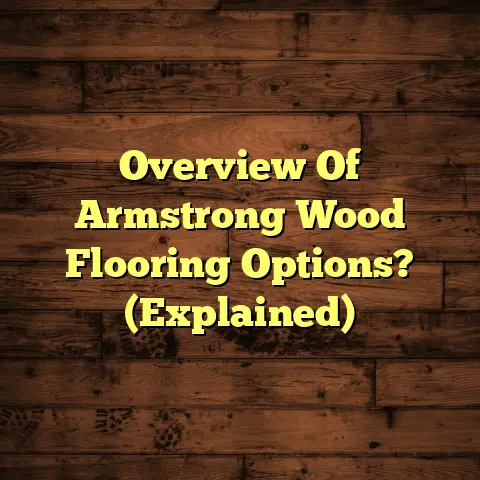Fixing Buckling Floating Floors (5 Minute Fix!)
One thing I hear a lot is that floating floors are a headache.
People think they’re super delicate and prone to problems like buckling.
But honestly? That’s a myth I want to bust today.
Floating floors are actually designed for easy installation and upkeep.
And most issues, including that pesky buckling, can be fixed fast.
Think under 5 minutes fast!
So, what’s buckling all about? Why does it happen?
And more importantly, how can we nip it in the bud without breaking a sweat?
Let’s dive in!
Section 1: Understanding
Floating Floors
Okay, first things first. Let’s get clear on what we’re talking about.
Define Floating Floors
A floating floor, simply put, isn’t nailed or glued down.
Instead, the planks or tiles lock together, “floating” above the subfloor.
Think of it like a puzzle where the pieces click to form one big surface.
This design makes installation a breeze and gives the floor some wiggle room.
This wiggle room is key for dealing with changes in temperature & humidity.
Types of Floating Floors
Now, not all floating floors are created equal.
You’ve got a few main players:
-
Laminate: Made of pressed wood
with a decorative layer on top.It’s budget-friendly and comes in
tons of styles, mimicking wood, stone, etc.But, it can be susceptible to moisture.
-
Engineered Wood: Features a thin
layer of real hardwood over plywood.It gives you the look and feel of solid
wood but is more stable and moisture-resistant.However, it’s pricier than laminate.
-
Vinyl: Made of synthetic materials,
it’s waterproof and super durable.It’s great for bathrooms and kitchens.
Plus, it’s available in planks (LVP)
or tiles (LVT), offering many design options.
Here’s a quick comparison table:
Source: National Wood Flooring Association
Installation Process
The beauty of floating floors lies in their easy install.
Typically, you’ll start with an underlayment to cushion the floor and reduce noise.
Then, you simply click the planks or tiles together, row by row.
No nails, no glue, no fuss!
The key is to leave a small gap around the perimeter of the room.
We call this an “expansion gap,” and it’s crucial.
It allows the floor to expand and contract with temperature changes.
Common Issues
Okay, so floating floors are great, but they’re not immune to problems.
Besides buckling, I often see issues like gapping, squeaking, and chipping.
But buckling is a big one, and it’s usually caused by one of a few things.
We’ll dig into those causes in the next section, so stay tuned!
Section 2: Causes of Buckling
in Floating Floors
So, why does buckling happen? Let’s break down the main culprits.
Moisture
Moisture is enemy number one when it comes to floating floors.
When the floor absorbs moisture, it expands.
And if there’s nowhere for it to go, it buckles.
Where does this moisture come from?
Think spills, leaky pipes, high humidity, or even moisture seeping up from the subfloor.
According to the EPA, indoor humidity should be between 30-50%.
Source: Environmental Protection Agency
Anything higher than that, and you’re asking for trouble.
Temperature Fluctuations
Just like moisture, temperature changes can cause expansion and contraction.
When it gets hot, the floor expands. When it gets cold, it contracts.
If these changes are extreme or frequent, the floor can start to buckle.
Think about a cabin that’s closed up all winter and then blasted with heat in the spring.
That’s a recipe for buckling!
Poor Installation
This is a big one.
If the floor isn’t installed correctly,
it’s almost guaranteed to buckle eventually.
The most common mistake?
Not leaving enough expansion gap.
If the floor is crammed too tightly against the walls, it has nowhere to expand.
Other installation errors include an uneven subfloor.
If the subfloor has dips or bumps, it can put stress on the flooring.
Heavy Furniture
Believe it or not, heavy furniture can contribute to buckling.
Think of a massive bookshelf or a grand piano sitting on the floor.
The weight can create pressure points, preventing the floor from expanding/contracting evenly.
Over time, this can lead to buckling.
Subfloor Issues
The subfloor is the foundation of your entire flooring system.
If it’s not in good shape, it can cause all sorts of problems.
A damp subfloor can wick moisture into the flooring, leading to expansion.
An uneven subfloor can create stress points and contribute to buckling.
Before installing a floating floor, always inspect the subfloor.
Make sure it’s clean, dry, level, and structurally sound.
Section 3: Identifying Buckling
Okay, so how do you know if your floating floor is buckling?
Here’s what to look for.
Signs of Buckling
The most obvious sign is, well, a raised area in the floor.
It might look like a hump or a wave. You might also notice:
-
Raised Edges: The edges of the
planks or tiles might be sticking up. -
Uneven Surfaces: The floor might
feel uneven when you walk on it. -
Gaps: You might see gaps forming
between the planks or tiles.
Sometimes, you can even hear a hollow sound when you walk over the buckled area.
Assessing the Severity
Once you’ve identified buckling, it’s time to assess how bad it is.
Is it a small, localized area, or is the entire floor affected?
Can you easily push the buckled area back into place?
If the buckling is minor and seems to be caused by a temporary issue.
Like a recent spill, you might be able to fix it yourself.
But if the buckling is severe, widespread, or accompanied by other issues.
Like water damage, it’s best to call in a professional.
Don’t try to force anything or make major repairs if you’re not comfortable.
You could end up making the problem worse.
Section 4: The 5-Minute Fix
for Buckling Floating Floors
Alright, let’s get to the good stuff.
The quick fix for minor buckling.
Remember, this is for small, localized buckling, not major water damage.
Step-by-Step Guide
Here’s a detailed guide to fixing buckling in five minutes (or less!).
Step 1: Identify the Problem Area
First, locate the buckled area and take a good look at it.
How big is it? How high is it raised?
Is it near a wall, a doorway, or a piece of furniture?
This will help you figure out what might be causing the problem.
Step 2: Clear the Area
Remove any furniture or obstacles from the buckled section.
You need to be able to access the floor freely.
This might involve moving a rug, shifting a chair, or even temporarily relocating a small table.
Step 3: Release Pressure
This is where the magic happens. Carefully pry up the affected floorboards.
Use a putty knife or a thin pry bar to gently lift the edge of the plank or tile.
You might need to work your way around the perimeter of the buckled area.
Be careful not to damage the flooring.
The goal is to relieve pressure,
not to rip anything apart.
Step 4: Adjust Expansion Gaps
Once you’ve released the pressure, check the expansion gaps around the edges.
Are they sufficient?
You should have a gap of about 1/4 to 3/8 of an inch between the flooring.
And the wall.
If the gap is too small, use a chisel or a utility knife to carefully trim.
The edge of the flooring. This will give it more room to expand.
Step 5: Reinstall Floorboards
Now, carefully reinstall the floorboards.
Line up the edges and gently press them
back into place.
You should hear a click as the planks or tiles lock together.
If they don’t click easily, don’t force them.
Make sure they’re properly aligned and that there’s no debris or obstructions.
Once the floorboards are back in place, walk over the area to ensure it’s even and secure.
Tips for Quick Fixes
Here are a few extra tips to make sure your quick fix holds:
-
Use a Rubber Mallet: If the
floorboards are difficult to click back.Use a rubber mallet to gently tap
them into place.This will help avoid damage.
-
Check for Moisture: Before
reinstalling the floorboards.Check for any signs of moisture
underneath.If you find moisture, dry the area
thoroughly before proceeding. -
Add Spacers: If you’re having
trouble maintaining the expansion gap.Use spacers (like small pieces of wood
or plastic) to hold the flooring away.From the wall while you’re working.
-
Monitor the Area: After you’ve
completed the fix, keep an eye on the area.Make sure the buckling doesn’t
return.If it does, you might need to
investigate further.
Section 5: Preventative Measures
to Avoid Future Buckling
Okay, so you’ve fixed the buckling. Now, let’s talk about prevention.
Here’s how to keep your floating floor in tip-top shape.
Moisture Control
As we’ve discussed, moisture is a major cause of buckling.
Here’s how to keep it at bay:
-
Clean Up Spills Immediately: Don’t
let spills sit on the floor.Wipe them up as soon as possible.
-
Use Doormats: Place doormats at
entrances to trap dirt and moisture. -
Ventilate Bathrooms and Kitchens:
Use exhaust fans to remove humidity. -
Check for Leaks: Regularly inspect
pipes, faucets, and appliances for leaks. -
Use a Dehumidifier: If you live in
a humid climate, use a dehumidifier to
keep indoor humidity levels in check.
Temperature Regulation
Extreme temperature fluctuations can also cause buckling.
Here’s how to minimize them:
-
Maintain a Consistent Temperature:
Avoid drastic temperature changes in your home.Set your thermostat to a comfortable,
consistent temperature. -
Use Curtains or Blinds: These can
help regulate temperature by blocking
out sunlight or trapping heat. -
Avoid Direct Sunlight: Direct
sunlight can cause the floor to overheat
and expand.Use window coverings to protect
the floor.
Proper Installation
Proper installation is key to preventing buckling.
If you’re installing the floor yourself, follow these best practices:
-
Read the Instructions: Carefully
read and follow the manufacturer’s
instructions. -
Prepare the Subfloor: Make sure
the subfloor is clean, dry, level, and
structurally sound. -
Leave an Expansion Gap: Leave
an adequate expansion gap around the
perimeter of the room. -
Use the Right Tools: Use the
right tools for the job, including a
tapping block and a pull bar.
If you’re not comfortable installing the floor yourself, hire a professional.
A professional installer will have the knowledge and experience to do the job right.
Furniture Placement
Here’s how to arrange furniture to avoid creating pressure points:
-
Use Furniture Pads: Place furniture
pads under the legs of heavy furniture
to distribute the weight. -
Avoid Overloading: Don’t overload
the floor with excessively heavy furniture. -
Rearrange Furniture Periodically:
Rearranging furniture can help prevent
pressure points from developing.
Conclusion
So, there you have it!
Floating floors are a fantastic option for homeowners looking for easy installation and maintenance.
And while buckling can be a concern, it’s often a quick and easy fix.
By understanding the causes of buckling and taking preventative measures.
You can keep your floating floor looking beautiful for years to come.
Don’t be afraid to tackle minor buckling issues yourself.
With a little know-how and a few simple tools, you can easily maintain the beauty and functionality of your floor.
But remember, if you’re ever unsure or the problem seems too big to handle.
Don’t hesitate to call in a professional.
Happy flooring!





